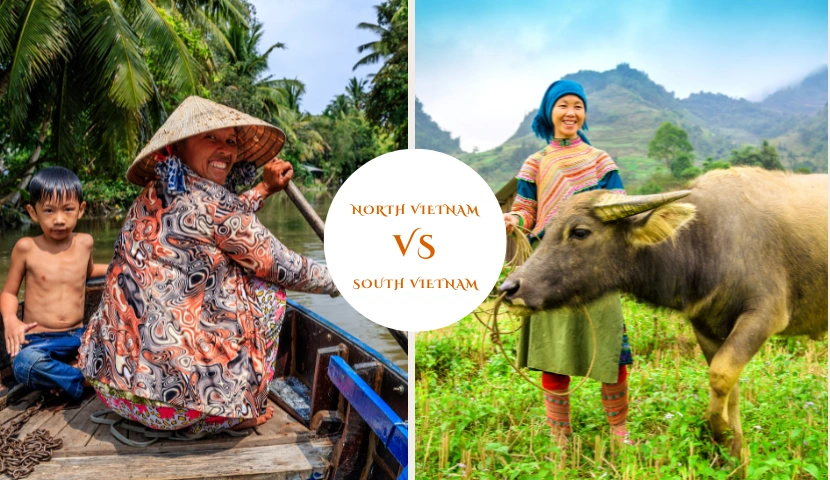Regional Differences: North vs. South Buying Behavior in Vietnam

Vietnam, though unified politically and economically, is still marked by significant regional differences in culture, consumer behavior, and business preferences—particularly between the North (centered around Hanoi) and the South (centered around Ho Chi Minh City). For global brands and investors, understanding these distinctions is critical to building an effective localization strategy, enhancing brand loyalty, and optimizing marketing spend.
This blog explores how and why buying behaviors differ between Northern and Southern Vietnamese consumers, offering practical insights and data-backed strategies for brands aiming to succeed across Vietnam’s regions.
1. Cultural Foundations Shaping Consumer Behavior
North Vietnam (Hanoi and Surrounding Areas)
The North, traditionally seen as more conservative and hierarchical, places strong emphasis on tradition, etiquette, and social formality. This affects the pace of buying decisions, preferences for status and premium brands, and loyalty toward established Vietnamese brands.
Key traits:
-
Cautious buying behavior
-
Preference for formality and protocol
-
Trust in state-owned brands and traditional businesses
-
Higher responsiveness to word-of-mouth and brand heritage
South Vietnam (Ho Chi Minh City and Surrounding Areas)
In contrast, the South is often described as entrepreneurial, dynamic, and open to new experiences. Southern consumers are more likely to embrace modern lifestyles, experiment with foreign brands, and purchase based on convenience.
Key traits:
-
Spontaneous buying habits
-
Favorable attitude toward Western products
-
Higher digital adoption for shopping and payments
-
Less emphasis on formality in transactions
Related Read: How Local Culture Influences Digital Buying Behavior in Vietnam
2. Regional Preferences in Product Categories
Fashion and Lifestyle
-
Northern consumers tend to favor subtle, elegant, and traditional styles, especially for formal wear. Local brands that emphasize heritage or craftsmanship, such as Viettien or An Phuoc, perform well.
-
Southern consumers are more adventurous, favoring modern, bold designs and global fashion trends. Brands like Zara, H&M, and local disruptors such as Coolmate thrive in the South.
Food and Beverage
-
In the North, traditional tastes dominate. Foods are less spicy, and there is a strong focus on quality and freshness. Northern buyers also favor sit-down dining experiences.
-
In the South, there’s more openness to street food, snacking culture, and fast food. International F&B chains like KFC, Starbucks, and Lotteria have larger footprints in Ho Chi Minh City.
Electronics and Tech
-
Both regions show high demand, but Southern buyers are more likely to adopt new models and gadgets early. Smartphone purchases in the South skew toward higher refresh rates.
-
Northern consumers are more cautious, often seeking value-for-money and post-purchase services.
3. Communication and Brand Messaging Differences
When it comes to advertising and digital marketing, regional tone matters:
-
Northern messaging works best when it emphasizes credibility, community values, and tradition. Celebrity endorsements and family-oriented storytelling resonate well.
-
Southern messaging should highlight individualism, innovation, lifestyle enhancement, and global aspirations. Humor and viral-style content gain traction.
Read more: Building Brand Awareness in Vietnam Through Social Media Marketing
4. Platform Preferences: Offline vs. Online Shopping
While both regions are rapidly adopting e-commerce, their preferences differ:
-
In the North, traditional retail still holds strong, particularly in wet markets and local specialty shops. However, platforms like Tiki.vn and Lazada are gaining share, especially among Gen Z.
-
The South has higher e-commerce penetration, led by platforms like Shopee and TikTok Shop. Many buyers use mobile-first platforms, combining shopping and entertainment.
Insight: How Vietnamese Consumers Use TikTok for Product Discovery
5. Payment Preferences and Financial Behavior
-
Northern buyers are still slightly more cash-reliant, especially in rural areas surrounding Hanoi. They tend to prefer bank transfers and ATM withdrawals.
-
In the South, especially urban areas like Ho Chi Minh City, there is greater adoption of e-wallets such as MoMo, ZaloPay, and VNPay, along with Buy Now, Pay Later (BNPL) options.
6. Role of Regional Agents and Localization Support
Hiring a Vietnam agent with regional expertise is critical to navigating these differences:
-
A Hanoi-based agent can help with government relations, B2B partnerships, and formal procurement.
-
A Ho Chi Minh City-based agent can provide faster access to retail networks, tech startups, and dynamic consumer segments.
Working with the right agent ensures localized messaging, pricing, and logistics strategies, ultimately improving brand success across Vietnam.
Need help localizing your business? Explore Vietnam-Agent.com for expert agent services across regions.
Conclusion: One Country, Two Distinct Markets
Vietnam’s North and South represent distinct markets within a unified economy. Understanding the cultural, social, and behavioral nuances between regions allows brands to tailor their marketing, sales, and operational strategies more effectively.
By respecting regional identities, investing in local insights, and working with the right in-country partners, foreign businesses can build trust and long-term loyalty across the entire Vietnamese consumer landscape.
Useful Links and References: